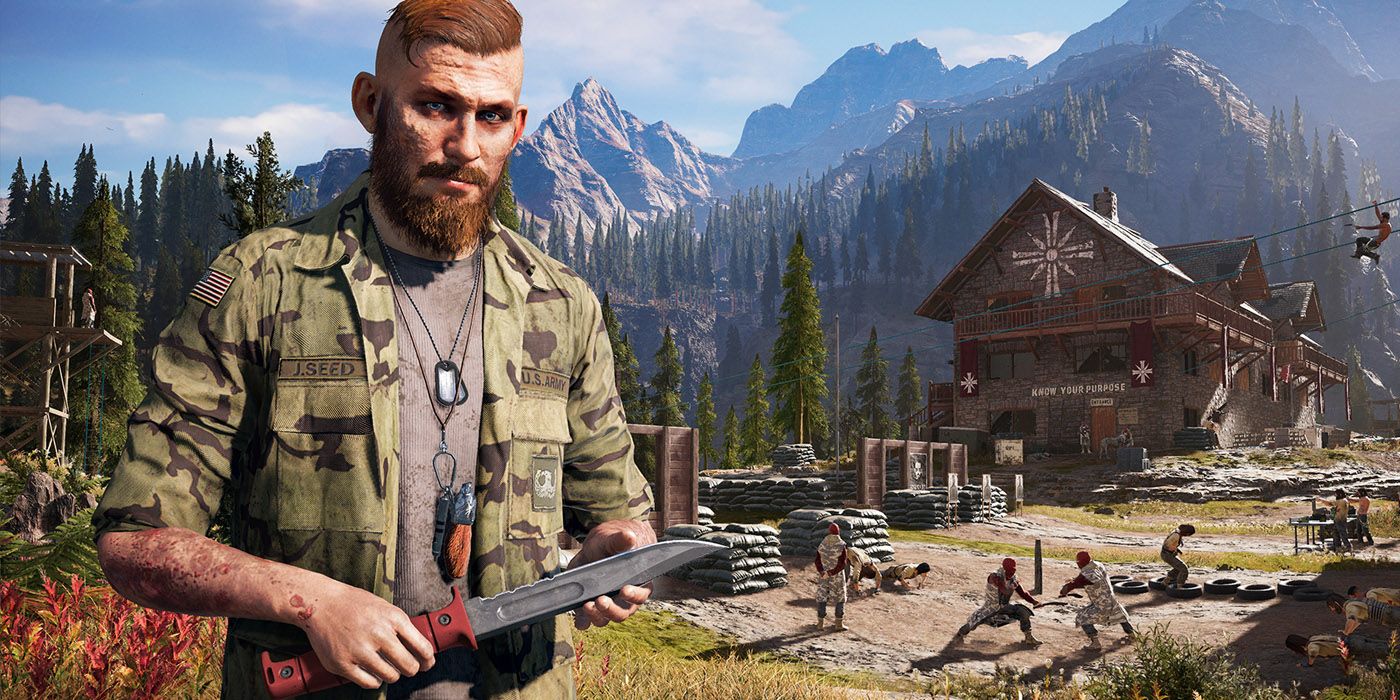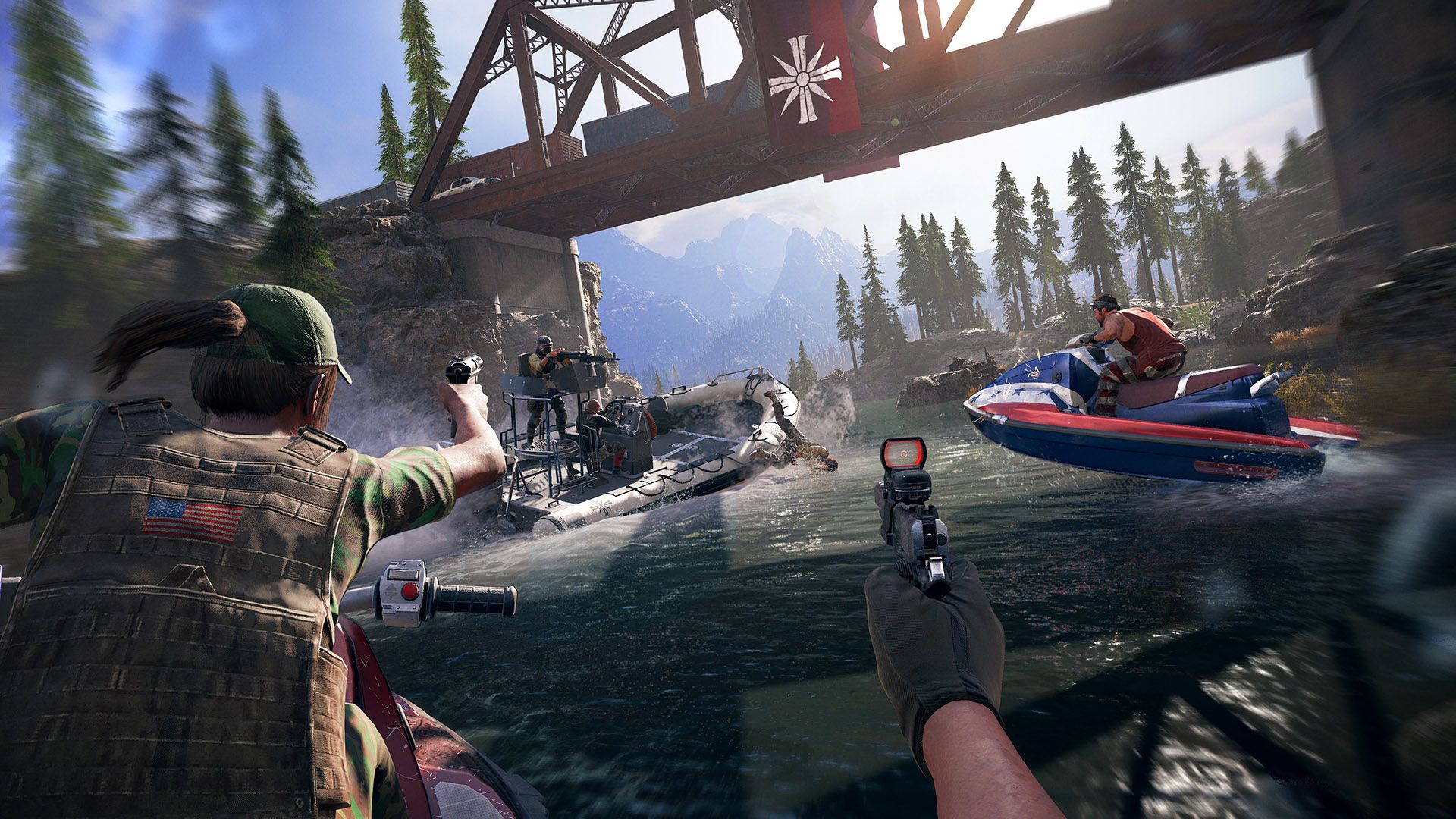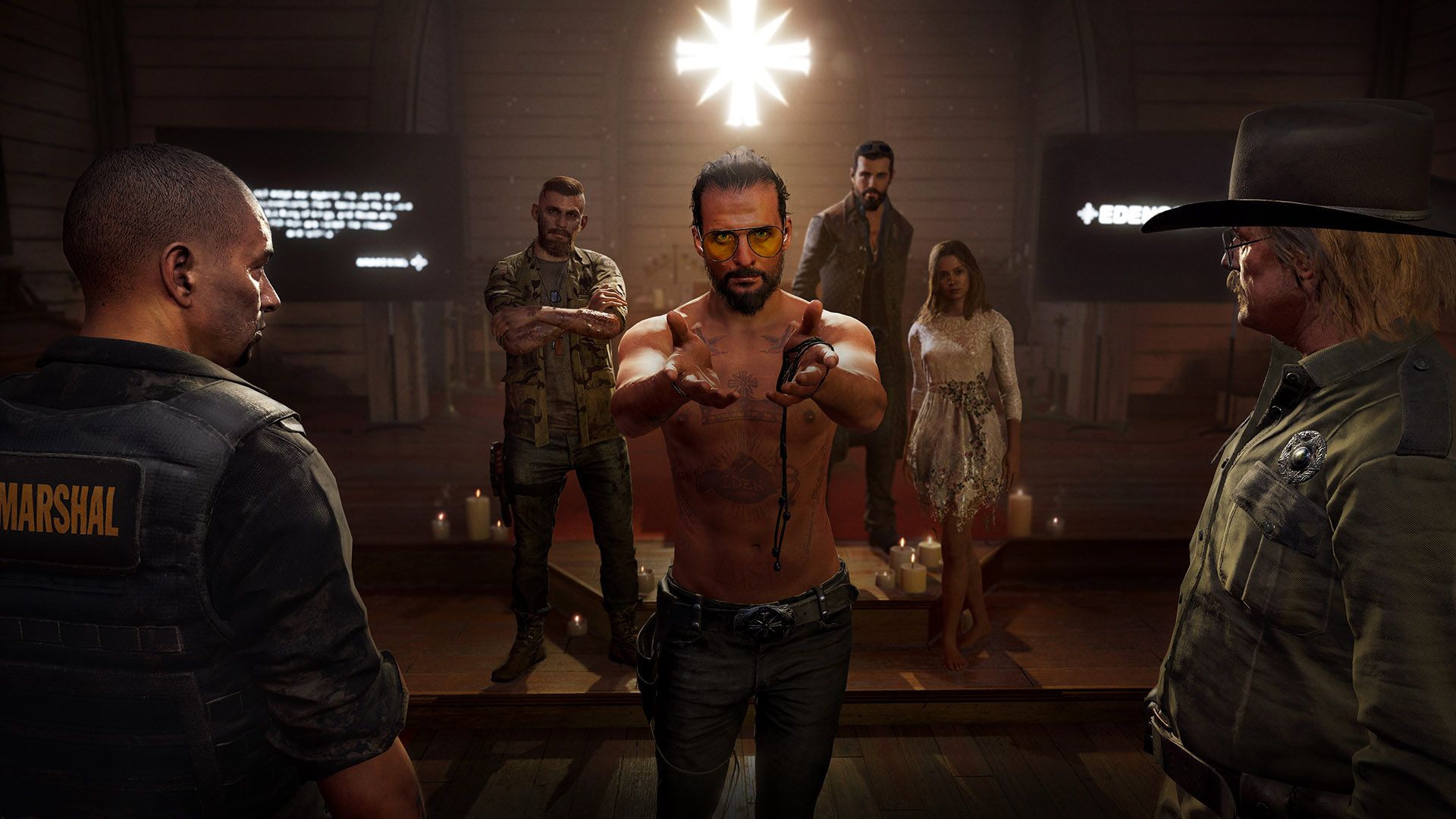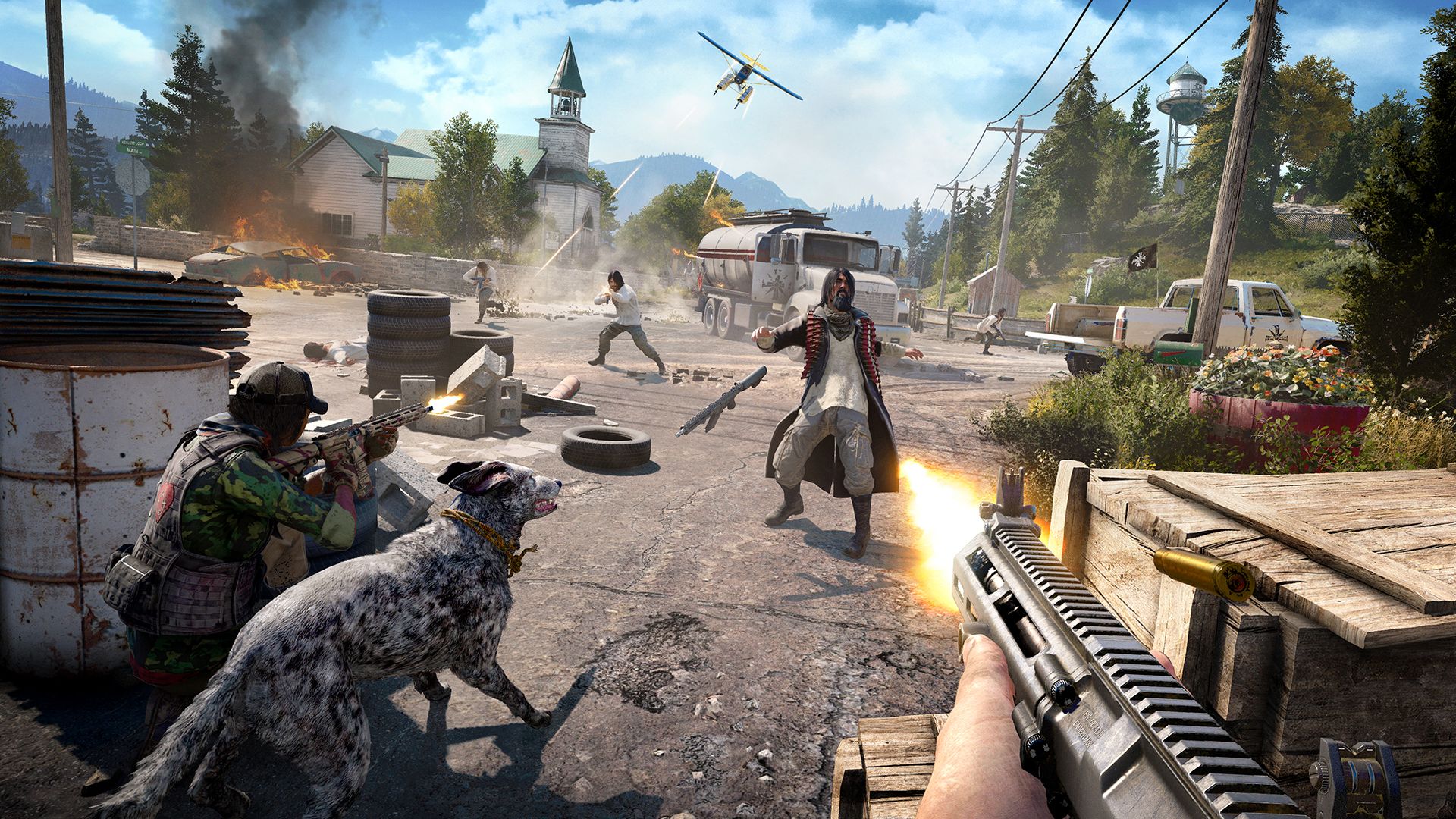Gamers familiar with the BioShock, Red Faction, and Saints Row franchises have likely enjoyed the work of Drew Holmes, and if not, they certainly will next week when Far Cry 5 finally releases. Holmes is the lead writer on Far Cry 5, one of our most anticipated games of 2018, and took the job after being pitched a game by franchise creative director Dan Hay that for the first time brings Far Cry the series to America.
That's something we can understand. Dan Hay sold us on the characters and setting of Far Cry 5 when we spoke to him a few weeks ago too, and similarly over the years has impressed me personally with how he spoke about Far Cry 3 and Far Cry 4 before this - the former being my 2012 game of the year.
Related: Far Cry 5's Arcade Mode is a Potential Game-Changer
Far Cry 5 is both pleasantly familiar, but notably refined. It takes the best elements of the last few main series installments and replaces some of the less-beloved parts (i.e. climbing towers) and combines it with a "choose your own adventure approach" and the most fleshed-out characters the franchise has ever seen. Given the size of this game, the amount of characters, and how complex a massive project this is for developer-publisher Ubisoft, we reached out to speak to Drew Holmes about the how his team approached the story and writing. The fact that Holmes says he's in it for the long haul, and seemingly planning to stick around with Ubisoft for Far Cry 6 (or whatever is next from the brand) and beyond speaks volumes.
Let's start at the beginning with how you first got involved with Far Cry 5.
DREW HOLMES: I was freelancing, in L.A at the time, and I just got contacted by somebody at Ubisoft saying, “Hey, we wanted to know if you’d be interested in coming up and seeing what was available, what was around? There’s an opening on a new Far Cry.” I was like, “Oh OK. That piques my interest.” Been a longtime fan of the franchise. So I came up and met with the team and then I sat down with Dan [Hay] for about 30 minutes and it went from me going, “Yeah, I’d be interested, though I’m not quite sure about moving to Montreal,” to end of that meeting going, “I’ve got to pack everything up. I don’t give a shit what happens. I don’t care if they say no. I’m taking this job. I want to work with them on this project.” It was a really super simple pitch, right? It was, “We’re sending Far Cry to America,” and I went, “Oh, that’s interesting. I don’t know if you can do that.” [Dan Hay] gave me the same pitch that he’s given in the past, and I was hooked. He said “It’s gonna be a cult. It’s gonna be one man at the forefront, and maybe a family. He’s got this very specific idea that the world is coming to an end and you’re playing this would-be deputy that’s got to stop him.” And that’s really all it was. I was like, “Alright, cool. Let’s just go on this ride and see where it goes.”
What variables (characters, set pieces, etc.) were set at that point?
DREW HOLMES: Really everything inside of that. Yes, there was a cult leader but we had no real identity in terms of who he was or what he stood for beyond God was telling him that the end of the world was coming. So for me, I really wanted to come in and try raise the bar for the characters across the board. The villain is the one thing you have to hit in a Far Cry game but I was looking at going – I want every single character you interact with in this game to really come across as someone that you can empathize with and you understand and they feel more three dimensional. I think that games, we always have a tendency to just paint very broadly, and I think that because you’re moving to the beats of the game play, which is great because that’s what the franchise is known for, I think that you tend to lose all the characters you’re interacting with over time. It was just more about, OK, if we’re going to be set in this sort of small town America, that’s where I grew up and I wanted to bring a lot more life and nuance and contradictions to all these characters that you meet and make them really, really fresh and new and people that you want to spend more time with. Make your resistance your partners. All the people who’ve helped you out in this journey, sort of stand toe-to-toe with the villains, because I think the team understands how to create “big bads." But it was just about bringing all these characters into the fold.
Speaking to Dan Hay about Far Cry 5, he emphasized that this one - more than previous entries in the series - is a choose your own-adventure. How do you write that out? Is it separate pieces you can opt into or do you intertwine events or character threads?
DREW HOLMES: Yeah. It’s fucking tough. I think we stepped on was viewing each regions as its own, like we’re building 3 seasons of a TV series in parallel. Where each region is telling its own contained story but Joseph is sitting over top of it all – you have this story with him that he’s sort of dipping in-and-out and each story of the region. The way we were approaching all the missions and all the stories, everything has to be self-contained and because we don’t quite know where you’re going to be interacting with these characters at any given point, but what we did on the writing side was make sure that if any character or event that was happening in a mission, probably would have affected something that came before or after. We’ve got the ability in the game engine to sort of flip lines on the fly so that a character acknowledges that some big event has happened or the death of some key figure that may have an effect on the broad strokes - I'm trying to avoid spoilers - But the whole idea was that everything felt cohesive and nothing felt off. So you don’t think, “No. This character would’ve known about this.” And all the sudden you’re pulled out of it because you’re seeing how the “sausage is being made” and you see that this character really isn’t engaged in anything else – but there were little tweaks along the way to prevent that. Overall it was just making sure that scenes were written in a way to be agnostic to where they could occur in the timeline. But at the same time it’s gotta be filled with drama, there’s gotta be conflict in it. You gotta be sort of driving through the scenes. I think, overall, we did a pretty damn good job of making sure that no matter which way you’re going, no matter who you’re talking to, everything really feels like it’s pulled along by this rollercoaster of the game itself.
And there other writers (Liz Alb, Kyle Muir, Christina Ray) on this project - how is that work divided out?
DREW HOLMES: Yeah, for sure. It was the largest writing team that Far Cry had by far, or so I’m told. We had at our peak, 12 writers, I want to say? It was 9 or 10 here in Montreal. We had somewhere between 2 to 3, at any given point at the Toronto studio and I had some freelance guys, as well, helping out. They were based in L.A. We broke it [responsibilities] down by seniority. The more senior writers would be in charge of each region, so you have someone who was looking top down at that region story and the key community characters within that, with me watching all the cinematics and meta-story of the lieutenants and how those key cut scenes are weaving into the gameplay. So we have those other guys underneath really focusing on dealing with the mission design team, global design team, to make sure the story we wanted to tell was being fed into the actual quests. Then we would break off, there’s a lot of side characters and side content, so we’d throw 2 or 3 characters at different writers to say, “You own this character’s voice. Sit down with the quest guys, work out what they want to do, and then as that’s all getting shaped up, then I would come in and jump into recordings to make sure that voices are consistent for the overall world view. But allowing for that many writers to have input on all the different characters, for me, I have my point-of-view, how I see the world, and having all these different women and men bringing themselves into these roles helped us have a cast that large not feel like it’s coming all from one voice. So I can just come in and do a clean-up pass and make sure that everything was feeling smooth going into recording. One of the people on the writing team had mentioned about a month ago, you can see bits and pieces of all the different writers who have worked on this project but at the same time, it doesn’t feel scattershot in a way that I think it could. It all feels like it working towards one goal, which is good – especially when you’re working with a team that size.
Where there any major changes on your end mid-development?
DREW HOLMES: No, the story and the game we set out to make is consistent with what we set out to go through. There’s always big change ups when you find the right person to cast and you go, “Oh, you know what? This character that we didn’t quite see it having the impact. Now all the sudden, because of the actor in the right spot and us having a breakthrough in terms of where to push the story, it evolves. And as gameplay evolves you OK a certain mission idea that we wanted to have, but we can quite get it to work, so we have to re-shift the focus here. But that’s just typical, standard game development problems that crop up along the way.
Are there Ideas you were fond of but couldn’t fit into this game?
DREW HOLMES: Probably? I can’t think of any off the top of my head but I subscribe to the mantra of Kill Your Darlings where, if you’re trying to hold on to something too much to the point where it’s detrimental to everything that’s happening? Then you have to do what’s best for the game itself and the story that you’re trying to tell. In the end, there are infinite possibilities in terms of where a story could go, but the end product is really the only way it could’ve been written. I think for us, looking at it, I’m really, really proud of where we wound up and I think that, as people get their hands on it, they’ve been playing through the experience, they’re responding to it in a really positive way – which is good.
The Far Cry 5 DLC covers a lot of new ground - zombies, Mars, Vietnam - are you involved with those? Any ideas you want to see explored in those?
DREW HOLMES: Yes. On a high level, looking at fleshing out the story line, fleshing out the characters, just making sure that that world consistency is there. I’m doing less hands-on stuff just because I’m so wrapped up in the push to get this game out the door, but all the people who’ve been involved along the way are working on the DLC It’s like a way to hand off some bigger chunks to writers who’ve done an exceptional job on the team on Far Cry 5. But I think overall in terms of tone and what we want to do with it, yeah, we’re looking at things like Blood Dragon. I think what’s cool about the Far Cry brand is that it can be spun off into all these fun, over-the-top scenarios and Dan and I always talk about how Far Cry, I think for us, it’s almost like an anthology series for us in a way. Where we can tell all sorts of outlandish stories but all feel similar in tone. But just because we set a Far Cry in Montana doesn’t mean that we can’t set one on Mars or have it deal with zombies. We’ll bring little bits and pieces of characters maybe that you’ve seen in Far Cry 5 and put them in this situation and go, “OK. How would this character react when presented with zombies or a game found on Mars.”
You’re embedded into the franchise now - as a fan what would you love to see from a crazy DLC or Far Cry 6? Something that’s never been explored before in the series.
DREW HOLMES: Oh man. There’s so many ideas and if I give away anything it’s going to be a problem. A dart gun would come out somewhere and you’d never see me again. [Laughs] I think the Mars scene, in particular, is one that we’re going to have a lot of fun with. Ideas for the future. We’re always thinking. We’ve got some things up our sleeve.
The previous franchises you worked on, Red Faction, Saints Row, BioShock, are not currently active. If you could reboot one of those with a new idea, which one would you choose?
DREW HOLMES: [Laughs] Oh man! That’s a good question. I haven’t given any thought to that, just because everything is so focus on Far Cry. I do think that…you know…I just haven’t given any thought to that. It’s in the past, man.
What’s next for you? Where can fans see you next after Far Cry 5?
DREW HOLMES: That… is… strictly confidential, unfortunately. No, I’m going to give you something – I’m in it for the long run, but I’m going to take about a month off [vacation] in April. But I think for me, I’m really committed to Far Cry for the long term. I’m excited to see what new stories we can spinoff from there.





